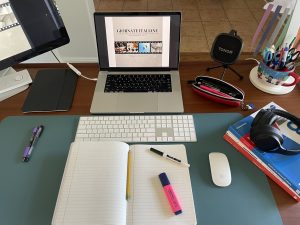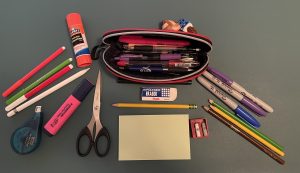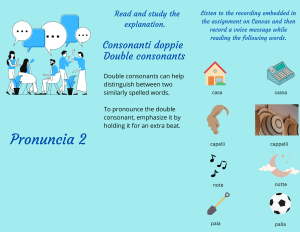Unità 2 – Una giornata in università
Learning Objectives – Unità 2 – Una giornata in università
Have you ever wondered how and if students leave home to study in Italian universities?
In this unit you will learn to talk about your courses and daily routine as well as to describe your professors and classmates. From a cultural point of view, you will learn about the Italian university system and how it differs from the American system.
2.1 Che cosa c’è in classe?
A CASA
Study the vocabulary "La classe e la cartoleria" and the grammar "Gli aggettivi", then do the exercises embedded in this book at your own pace while you study.
2.2 I compagni di classe
IN CLASSE
Vocabolario: “La classe“
Grammatica: “Gli aggettivi”
Attività 1
Step 1 – Work in pairs, look at the pictures and complete the sentences with one of the given adjectives.
| difficile | noioso | grande |
| interessante | piccolo | facile |
| Studente 1 | Studente 2 |

L’aula è … |

L’aula è… |

La lezione è… |

La lezione è… |

L’esercizio è … |

L’esercizio è… |
Step 2 – Think about other adjectives that you can use to describe the images and write short sentences. You can use wordreferences.com to look up new adjectives.
Step 3 – Pick one picture in your column (Studente 1 or Studente 2) and describe what is there and what is not there. The other students guess what picture you are describing.
Step 4 : Play with the whole class.
Riflettiamo: L’Aggettivo
Work in pairs, read the following sentences think and review the rule with your peers. Then transform all the sentences into plural.
- L’aula è piccola
- L’esercizio è lungo
- La lezione è divertente.
- Il professore è serio.
Now fill the blanks with the correct endings and explain the reason for each choice.
Lo studente è brav_ e intelligent_
La penna ross_
Il banco nuov_
Le sedie scomod_
I cestini pien_
La professoressa interessant_ ma noios_
Attività 2 – What do I need for my class?
Situation: Giulio is a new student in your class. This is his first day and he doesn’t know what to take to class. Help him making the shopping list for the stationary he needs.
Step 1 – Look at the images below and name as many object as you can in 1 minute, use the timer.
| Immagine 1 | Immagine 2 |
|
|
|
Step 2 – Check your backpack and tell your classmates what there is (not).
Step 3 – Check the following websites Pigna.it and RDcartoleriaonline.it to help Giulio make a shopping list of the stationary he needs to bring to class for the following courses.
Note to the instructor: make students fill the sentences with numbers / indefinite articles and adjectives.
- Per la lezione di italiano tu hai bisogno di…
- Per la lezione di matematica tu hai bisogno di…
- Per la lezione di filosofia tu hai bisogno di…
- Per la lezione di architettura tu hai bisogno di…
Step 4 – Share your list with the whole class.
2.3 Cosa porto a scuola…
A CASA
Study the vocabulary: "La classe e la cartoleria" and the grammar: "Gli aggettivi" e "I verbi regolari in -ARE" then do the exercises embedded in this book at your own pace while you study.
Ascoltiamo 2
Cosa porto a scuola…
Go to Canvas to complete Ascoltiamo#2
Follow this link and watch the video Mega HAUL di Cartoleria – Stationary HAUL by Elena Tee on Youtube. Then go to Canvas and complete the comprehension questions.
2.4 I miei compagni di classe
IN CLASSE
Vocabolario: “La classe”
Grammatica: “I verbi regolari in -ARE”
Attività 1 – Revisione dei verbi regolari in -ARE
Step 1 – Look at the images below and match them with the given verbs. Be aware that more than one verb can be used to describe the same picture and the same verb can be used to describe different pictures.
| ascoltare | pensare | ordinare | guidare | insegnare | chiamare | incontrare | usare | mangiare |
| lavorare | pagare | comprare | tornare | telefonare | studiare | viaggiare | imparare | portare |
 |
 |
 |
 |
 |
 |
 |
 |
 |
Step 2 –
Riflettiamo: I verbi regolari in -ARE
Complete the following exercise then discuss and explain the rule with your classmates and your instructor
Step 3 : Work in group of 4, pick two pictures each and make up sentences with the verbs that you used to describe those pictures. You can use the online die to pick different subjects.
| 1 = io / 2 = tu / 3 = lui o lei / 4 = noi / 5 = voi / 6 = loro |
Step 4 – Share your sentences with the class. The group with the most creative sentences win.
Attività 2 – Studio italiano perché…

Situazione: You are in Siena to take an Italian course for foreign students and you read the classroom blog with your classmates introductions.
Compito: Leave a post where you introduce yourself and say why you study Italian.
Step 1 – Work in pairs and take turns reading the posts aloud.
Step 2
Look for the following verbs in the text above and try to understand their meaning, then match the Italian with the English translation.
| Italiano | Inglese |
| frequento | I play (an instrument) |
| suono | I study |
| imparare | to love / to adore |
| studio | to improve |
| migliorare | to learn |
| adorare | I attend |
Step 3. Work in pairs and use the examples and the explanations activity 1 and 2 then write a short post where you introduce yourself to your classmates and say why you study Italian and describe your classmates.
Step 4. Read your post to the class.
2.5 Intervista a un professore italiano
A casa
Study Preposizioni semplici – (Only Prepositions with places A / IN / DA)
Leggiamo 2
Intervista a un professore italiano
Go to Canvas to complete Leggiamo#2
In Italia ci sono molte università. Ma come entrano gli studenti italiani all’università? Ecco l’intervista al professor Rossi.
Domanda: Professor Rossi, che cosa insegna e dove?
Risposta: Io sono professore associato in Antropologia e lavoro all’Università Alma Mater di Bologna.
Domanda: Com’è l’Università di Bologna?
Risposta: E’ un’università molto antica, fondata nel 1088. Per questo motivo, come tutte le università italiane, non ha un campus. Ha una sede centrale in un bellissimo edificio molto antico, ma le varie facoltà hanno sede in edifici diversi in diverse parti della città.
Domanda: Come sono le aule?
Risposta: Le aule sono moderne. In ogni classe c’è un proiettore, una lavagna bianca e una luminosa, c’è un impianto audio, banchi per gli studenti e la cattedra per i professori.
Domanda: Quali tipi di università esistono in Italia?
Risposta: In Italia ci sono università pubbliche o private. Per esempio l’Alma Mater di Bologna è un’università pubblica.
Domanda: Come entrano in Università gli studenti?
Risposta: Dopo il diploma della scuola superiore, gli studenti italiani o stranieri possono frequentare l’università che preferiscono, nella città che preferiscono. Per entrare in alcune facoltà come: medicina, economia e ingegneria ci sono test di ingresso, ma altre facoltà non hanno un test di ingresso.
Domanda: Quanti anni durano i corsi universitari?
Risposta: I corsi di laurea durano 3 oppure 5 anni e finiscono con un diploma di laurea. Gli studenti iniziano con una laurea di primo livello che dura tre anni, poi possono continuare con una laurea magistrale che dura due anni.
Domanda: Quanto costa l’Università in Italia?
Risposta: Il costo dell’università dipende dal reddito degli studenti. Le università pubbliche costano in media 4.000 euro per un anno accademico. Le università private costano in media 8.000 euro per un anno accademico.
Domanda: Come sono i corsi e gli esami?
Risposta: I corsi sono difficili e anche gli esami. Gli studenti danno tutti gli esami alla fine del semestre, gli esami sono orali e scritti a seconda del corso.
Domanda: Quanti studenti frequentano l’Alma Mater di Bologna?
Risposta: Nel 2022 ci sono 90.000 studenti iscritti all’Università di Bologna.
Domanda: Ci sono studenti stranieri all’università di Bologna?
Risposta: Si, ci sono studenti di tutte le nazioni: inglesi, cinesi, americani, indiani, giapponesi. Grazie al programma Erasmus ci sono soprattutto molti studenti europei: francesi, tedeschi e spagnoli, olandesi.
2.6 L’università
A casa
Study the vocabulary: "L’università" and the grammar "I verbi irregolari in -ARE" then do the exercises embedded in this book at your own pace while you study.
2.7 Una giornata in università
In classe
Vocabolario “L’università”
Grammatica “I verbi irregolari in -ARE”
Attività 1 – Revisione dei verbi
Step 1: Watch the video: Una giornata in Bicocca and discuss in your group what she does on her first day at the university.
Step 2: Look at the images in the chart below and describe them using the given expressions. Remember that you can also use the negative form.
| fare attenzione / stare attento / stare zitto | dare un esame | dare una mano |
| andare d’accordo | andare bene/male | fare una domanda |
| Studente 1 | Studente 2 |
 |
 |
 |
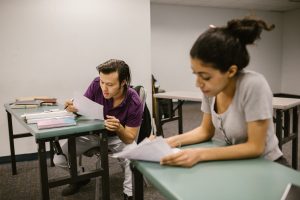 |
 |
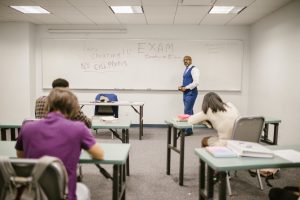 |
 |
 |
Step 3 In your group discuss about what you do on a typical day at UT using the verbs you’ve studied so far. Write down a few sentences as examples on your notebook
Step 4 Read your sentences to the class.
Attività 2
Situazione: Your Italian friend is attending a walking tour of UT.
Compito: Work in groups to give a tour of UT where you show the main buildings and explain what they are used for.
Step 1 – Go to UT-Map locate the most important buildings and use the document "UT- Walking Tour" to write down the translation in Italian. The group who writes all of them without spelling mistakes wins!
Step 2 – For each building explain, in simple words, what students and faculty do in those buildings, what’s in there, etc…
Step 3 – Pretend to go for a (virtual) tour with your friend and show them pictures from the internet while you explain the use of those buildings.
Step 4 – Read at least one example to your instructor OR Give the tour inside the classroom.
2.8 Io e i miei compagni
A Casa
Review the vocabulary: "L’università" e "i giorni" and the grammar: "I verbi irregolari in -ARE" then do the exercises embedded in this book at your own pace while you study.
Parliamo 2
Io e i miei compagni
Go to Canvas to complete Parliamo#2
Registra un video messaggio mentre leggi le domande seguenti e poi rispondi con frasi complete in italiano.
Record a video message while you read (one at a time) and answer the following questions with complete sentences in Italian.
- Che cosa studi?
- Cosa fanno i tuoi compagni a lezione?
- Dai una mano ai tuoi compagni?
- Quali giorni studiate insieme?
2.9 – I miei corsi
In classe
Vocabolario “L’università” e “i giorni”
Grammatica: “I verbi irregolari in -ARE”
Scriviamo 2
I miei corsi
Write a short composition of 40-60 words in Italian on the following topic
- Descrivi la tua giornata tipica in università.
Use the following questions as suggestions:
- Quali corsi frequenti?
- Quando vai in biblioteca?
- Quando fai una presentazione?
- Quali giorni va in università?
Wordwall – Domande di revisione unità 1 e 2
Attività 2 – Revisione verbi e vocabolario
Situazione: You are creating a study group for your Italian course.
Compito: Check you schedule with your classmates and decide when and where you can meet to study together.
Step 1 – Work in group of four and each student fills (in Italian) the chart below with their courses.
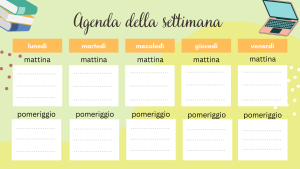
Step 2 – Think about questions, words and expressions that you can use to ask the availability to your classmates.
Step 3 – Write a short dialogue.
Step 4 – Play the dialogue in front of the class.
Hai finito l’unità 2, completa la Review Unit 2
You completed Unit 2, go to Canvas and complete Review Unit 2
schools
graduation
high school
entry test
can
income
average
academic year

